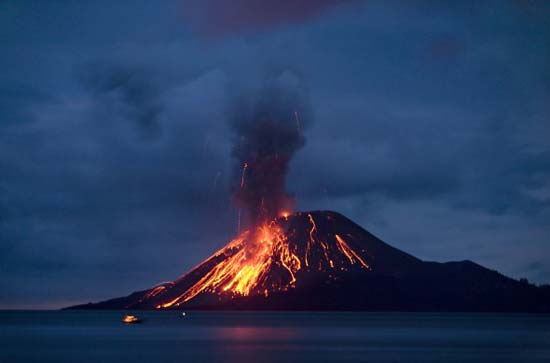Key volcano terms you need to know to understand these fiery geological structures

Today, about 500 million people live on or close to volcanoes, and while these geological wonders can be a hot spot for tourists, they can pose many hazards to surrounding communities when they erupt.
There are many scientific terms related to volcanic eruptions, and understanding them can help to explain the full spectrum of threats that arise from these fiery features.
A volcano can be a mountain that extends down to a pool of magma between the crust and mantle. It's basically a hole in the Earth from which magma emerges to release pressure inside the Earth.
Here are some common volcanic words and phrases to learn.
Ash
In this photo released by U.S. Geological Survey, a plume of ash rises from the Puu Oo vent on Hawaii's Kilaueaa Volcano. (U.S. Geological Survey via AP) People should avoid unnecessary exposure to ash and wear protective clothing, masks and goggles to ensure that ash contact with the body is at a minimum. The ash is formed during explosive volcanic eruptions when dissolved gases in magma expand and escape into the atmosphere. A fissure in a road in the Leilani Estates subdivision. (Scott Wiggers/Apau Hawaii Tours via AP) The Anak Krakatau (Child of Krakatau) volcano sends up powerful clouds of hot gasses, rocks, and lava as a fishing boat is moored offshore. (AP Photo/Ed Wray) The Hawaiian hot spot has been active for at least 70 million years, producing a volcanic chain that extends 3,750 miles across the northwestern Pacific Ocean. Hot spots also develop beneath continents, for example the Yellowstone hot spot, which has been active for at least 15 million years. The U.S. Geological Survey shows shows a layer of red ash on top of an active lava flow with surface breakouts in Kilauea Volcano in Hawaii Volcanoes National Park on Hawaii's Big Island. (U.S. Gelological Survey via AP) Mayon volcano spews molten lava during its sporadic eruption. (AP Photo/Bullit Marquez) Lava is magma that reaches the surface of our planet through a volcano vent. It is made up of crystals, volcanic glass and bubbles. Lava flows on the Pu'u O'o crater on Kilauea Volcano in Hawaii. (AP Photo/Tim Wright) Essentially, it is an area where the volcano is splitting apart. The rock is weak and cracked, making it easier for magma to reach the surface. Rift zones are a feature of some volcanoes, especially shield volcanoes. Diamond Head crater and Waikiki high rises are barely visible due to high levels of volcanic fog shrouding Oahu. (AP Photo/Marco Garcia) Vog, similar to ash, can also be detrimental to people's health. Sulfur dioxide irritates the skin as well as the eyes, nose, throat and lungs. The symptoms can include pain when taking a deep breath, coughing, throat irritation and breathing difficulties. A lava flow moves across Makamae Street in the Leilani Estates subdivision near Pahoa on the island of Hawaii. (U.S. Geological Survey via AP) A volcanic vent is a spot in the Earth’s crust where gases, molten rock, lava and rocks erupt. Volcanic vents can be at the top large volcanoes or they can be openings in the Earth’s crust. Volcanic bombs. (Hans/pixabay) These bombs are shaped while flying through the air and usually take aerodynamic forms. While in the air, after ejection, they cool into solid or semi-solid rock before hitting the ground. 
Volcanic ash is composed of fine particles of fragmented volcanic rock, which are able to irritate lungs, eyes and airways. Fissures

A volcanic fissure, also known as a fissure vent, is a linear vent through which lava erupts, typically without explosive activity.Hot spots

Hot spots are places within the Earth's crust where rocks melt to generate magma. Magma

Magma is composed of molten rock and is stored in the Earth's crust. Once the magma reaches the Earth's surface, it is called lava.Lava

Lava is hot liquid rock that can blast violently out of a volcano. Rift zone

A rift zone is a linear series of cracks or rifts typically forming into two or three well-defined regions. 
Vog

Volcanic smog is a form of air pollution that results when sulfur dioxide and other gases and particles emitted by an erupting volcano react with oxygen and moisture in the presence of sunlight.Volcanic vents

Volcanic bombs

Volcanic bombs are masses of molten rock formed when large fragments of lava are ejected from a volcano.

